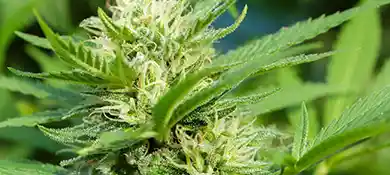How to Regulate Humidity: Do Fans Lower Humidity?
As a cannabis cultivator, you're undoubtedly aware of the significant impact temperature and humidity have on your plants' well-being. Excessive moisture can result in mold, mildew, and other issues that compromise the quality and quantity of your harvest.
A question often arises in the cannabis growing community is whether fans can help reduce humidity levels in grow rooms. Absolutely, fans can play a crucial role in safeguarding your plants.
In this blog post, we'll delve into the ways fans aid in managing humidity within your cannabis grow room and offer guidance on how to utilize them efficiently to avert mold and other potential plant issues.

Do Fans Lower Humidity? Understanding the Basics
Before exploring the benefits of fans in lowering humidity, let's first grasp the fundamentals of moisture. Humidity refers to the dryness and humidity of water vapor in the air, and relative humidity refers to the percentage of the water vapor pressure in the air and the saturated water vapor pressure at the same temperature.
Each stage of cannabis plant growth requires a different level of humidity. The ideal RH level for a cannabis plant during the vegetative stage is 40-70%. During flowering, the outstanding RH level is between 40-50%.
Anything above that can cause mold and other problems with the type of fan. Elevated humidity during the vegetative stage fosters leaf development, whereas reduced humidity in the flowering stage helps avert bud mold.
For cannabis growers, humidity plays a pivotal role in plant health, growth, and yield. Excessive moisture can lead to mold, mildew, and rot in cannabis plants, slowing growth and diminishing profits.
Thus, it's crucial to maintain optimal humidity levels to prevent such issues. Conversely, low humidity can cause cannabis plant leaves to curl up and become fragile. It can also drive slower growth and lower yields. It can also make plants more susceptible to pests.
The Role of Fans in Regulating Humidity
Fans help regulate humidity by improving airflow in the grow room. When the air stagnates, it creates pockets of high humidity where moisture can accumulate.
Using fans to move air around can prevent moisture from settling and create more consistent RH levels throughout the grow room.
Evaluating Different Types of Fans
There are several types of fans you can use in your grow room:
1. Inline Followers
Inline fans are multipurpose fans that can be used with carbon filters to remove unwanted odors from grow rooms. Inline fans are quiet, have high CFM ratings, and have a variety of sizes to fit any space.
2. Wall-mounted fan
As the name suggests, wall-mounted fans are mounted to the walls of the grow room. They are perfect for small grow rooms, being compact and affordable. In addition, wall-mounted fans are an excellent option for growers looking to save floor space.
3. Oscillating fan
Oscillating fans are ideal for larger grow rooms. They move back and forth, provide excellent coverage and ensure your plants get adequate air circulation. Rocking fans come in different sizes, so find the best fit for your grow room.
4. Tower fan
Tower fans are ideal for larger grow rooms or grow tents. They distribute airflow evenly throughout the grow room and provide a sleek, modern look. They are also quiet, energy efficient, and easy to install.
5. Axial fans
Axial fans are unique in providing higher airflow rates than other fans. As a result, they're great for moving warm air out of grow rooms, making them ideal for hot environments or environments without air conditioning.
6. Clip Fan
Clip fans are the smallest and most affordable option on this list. They clip onto anything from grow tent poles to grow trellises and provide localized air circulation. These fans are ideal for compact grow spaces or tents, and their portability is a fantastic feature for cultivators who frequently rearrange their plants.
Six fan types rank among the top choices for cannabis growers. However, remember to consider a few essential factors to guarantee optimal airflow in your grow room regardless of the type you select.
Precautions
1. Place
When positioning the fan, aim it at the leaves of the plants. It is best to have the fan no more than 2-3 feet from the plants, blowing air over the tops of the plants.
2. Direction
The direction of airflow is essential. Ensure the fan blows air over the tops of the plants and away from plants at the bottom. This creates a "turbulent" canopy that encourages the plants to sway and move, creating stronger stems.
3. Timer
To optimize fan usage, consider investing in a timer. A timer lets you schedule the fan to activate and deactivate at designated times, providing steady, uniform airflow all day.
4. Filter
Lastly, if you employ carbon filters in your grow room, use a fan of the appropriate size to match the filter. A little fan won't pull sufficient air through the filter, rendering it ineffective.
Getting the right fan in the right place can mean distinguishing between a healthy crop and a room full of diseased plants. So, let's look at the factors that can influence the fan choices of cannabis growers and their growing space.
Factors Influencing the Selection of Fans
1. Expand the room size
Your grow room size will determine the number and size of fans you need. Larger spaces require more fans than smaller rooms to maintain proper airflow.
2. Planting room shape
The shape of the grow room will also determine the placement of the fans. For example, square or rectangular rooms require fans to be placed in opposite corners for proper airflow, while oddly shaped rooms may require additional or unusual fan placement.
3. Temperature control
Temperature control is critical to cannabis cultivation. Proper airflow helps control temperature and prevent hot spots.
4. Humidity control
Humidity control is critical as too much humidity can lead to mold and bud rot. A fan can help reduce humidity levels and prevent these problems.
5. Air quality
Plants need fresh air to grow; proper ventilation helps maintain optimal air quality. A fan can help filter out impurities and provide fresh air circulation.
6. Noise level
Fans can be loud, and fans can spoil the growing room environment. Therefore, quiet fans with low-decibel noise should be selected to minimize disturbance.
7. Power consumption
The power consumption of the fan can increase rapidly. Therefore, high-efficiency fans with low energy consumption should be selected to help reduce operating costs.
8. Fan type
Inline, oscillating, and exhaust fans are options for cannabis grow rooms. Each type serves a different purpose and should be selected based on the needs of your grow room.
9. brand and quality
Not all fans are created equal, and investing in quality fans will last is essential. It's a good idea to research different makes and models to find the best lover for your grow room.
10. Budget
In the end, budget plays a significant role in fan selection. While high-quality fans may be more expensive upfront, their energy efficiency and durability can save you money in the long run.
Using Fans Alongside Other Humidity Control Methods
While fans can be a powerful tool for controlling humidity levels in a cannabis grow room, they work best with other methods.
1. Install dehumidifiers
Dehumidifiers are designed to remove moisture from the air for a comfortable environment. It operates by drawing air from the grow chamber and directing it over cooling coils, which condense vapors from the perspective.
2. Establish a ventilation system
Proper ventilation removes stale air and brings fresh air into the growth chamber. To create a ventilation system, you will need an exhaust fan to remove thick air and an intake fan to bring in the fresh air. Using an oscillating fan also helps with air circulation throughout the grow room.
3. Introducing a humidifier to the room
Though it might appear counterproductive, increasing the humidity level in your grow room can assist in managing humidity levels. A humidifier introduces moisture to the air, aiding in humidity control. Moreover, a hygrometer will help you determine the ideal humidity level for your grow room.
4. Use a drip irrigation system
A drip irrigation system is a method of watering plants where water is delivered slowly and directly to the roots. A drip irrigation system can help limit the amount of water applied to the plants, lowering the growth room's humidity levels.
5. Rely on natural methods
Adding moisture-absorbing plants like spider plants or peace lilies can help regulate humidity levels. To achieve the best humidity in your grow room, there are a variety of methods that growers can use. Ventilation systems, dehumidifiers or humidifiers, natural methods, and drip irrigation systems can all work effectively in conjunction with fans. However, one of the simplest and most effective ways to reduce humidity in the growing room is to open windows and utilize natural light.
Proper humidity control is critical to producing a healthy, high-quality crop, and by following these tips, growers can achieve the desired results in their growing room.
Monitor and Adjust Your Fan Settings Regularly
It is essential to adjust regularly and monitor fan settings to maintain optimal humidity levels in your cannabis grow room.
1. Different growth stages require different fan settings
As plants grow and mature, their environmental requirements change. For example, plants require more humidity and lower temperatures during the vegetative phase. During flowering, they need less moisture and higher temperatures. Adjusting fan settings to match the growth stage of your plants is critical for optimal growth.
2. Fan speed affects the strength of the plants
The strength of plants is directly related to the amount of wind they experience. If the fan speed is too high, your plants may be damaged and stunted growth. If the fan speed is too low, they will not develop enough power to support their growth.
3. Improper fan settings can cause plant stress
If your fans are not set up correctly, they can cause plant stress. For example, if the humidity level in your grow room is too high and the fan speed is too low, your plants may be stressed, resulting in poor growth and reduced yields.
4. The fan can prevent insects and mildew
Proper ventilation will help keep pests and mold from growing inside your grow room. Pests and mildew thrive in warm, humid environments, so by maintaining adequate airflow with a fan, you can create an environment that isn't hospitable to these irritants.
5. Regular monitoring can detect problems early
Regularly monitoring your fan settings allows you to spot problems early on before they cause severe damage to your plants. For example, if the temperature in your growing room fluctuates more than usual, it may indicate a problem with your fan settings that needs to be addressed.
Conclusion
Fans can help regulate the humidity in your cannabis grow room. Using them systematically and monitoring relative humidity levels indoors can create the optimal environment for your plants to thrive. But remember that a fan alone may not be enough; whether you are a small or a large grower, you will likely need to use other tools, such as a dehumidifier, or air conditioner, to maintain proper humidity levels for your plants.
FAQ
1.Will fans reduce humidity?
Fans alone do not reduce humidity. They circulate air and can help prevent condensation, but they don't remove moisture.
2.Does a fan dry out the air?
Fans do not dry out the air. They help circulate air which can make the air feel cooler but does not change the moisture level.
3. What type of fans should I use in my cannabis grow room?
There are several types of fans that can be used to control humidity in a cannabis grow room. Oscillating fans are a popular choice because they can move air in multiple directions, helping to circulate moisture evenly throughout the room. Exhaust fans are another option, as they can remove moist air from the grow room and replace it with fresh, drier air from outside. However, it's important to choose the right fan size and placement within the room to ensure maximum effectiveness.
Share with your friends:
Popular Blogs on Altaqua:
Download Catalogue



